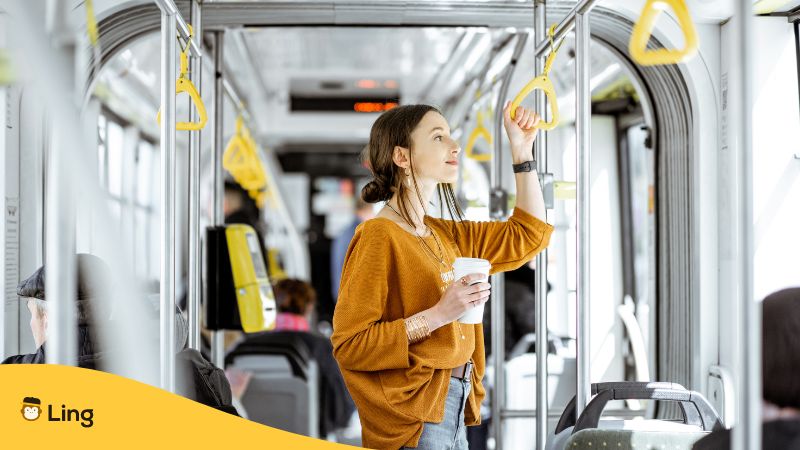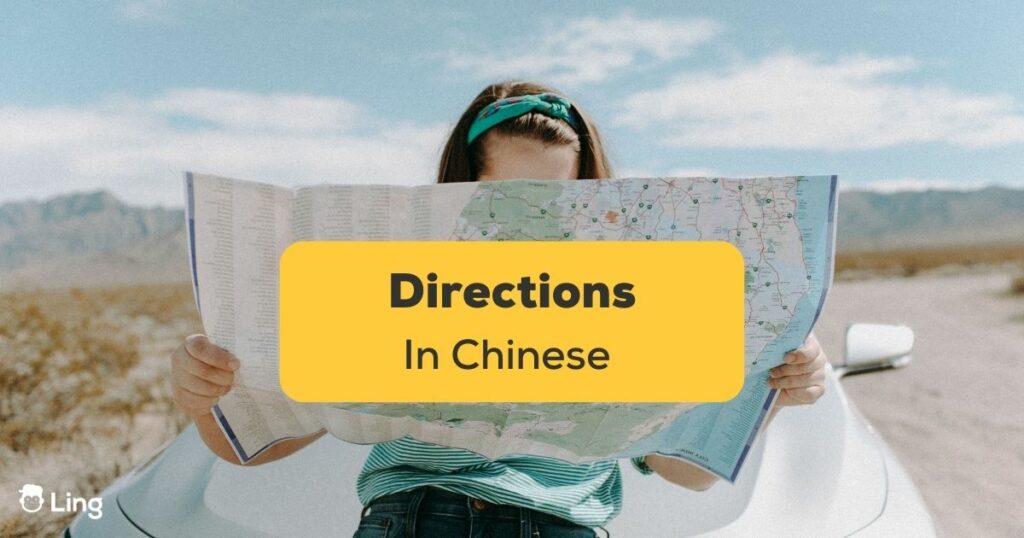China is a land of many wonders. From its rich cultural heritage to its thriving economy, it has become a popular destination for travelers worldwide. But for those planning to visit this vast and diverse country, knowing how to give and receive directions in Chinese is essential.
Not only does it make your trip easier, but it can also help you connect with locals and gain a deeper appreciation of the culture.
So, let’s take a journey through the streets of China taking different “方向/方向” (fāngxiàng), which is directions in English, and learning the essential vocabulary and tips for navigating this fascinating country.
Common Vocabulary And Phrases
To give effective directions in Chinese, it’s crucial to understand the common vocabulary and phrases used. For example, the words “左转/左轉” (zuǒ zhuǎn) means “turn left,” “右转/右轉” (yòu zhuǎn) means “turn right,” “直走/直走” (zhí zǒu) means “go straight,” “路口/路口” (lù kǒu) means “intersection,” and “停车标志/停車標誌志” (tíng chē biāo zhì) means “stop sign.” Knowing these terms will make it easier to understand and give directions in a variety of situations.
Here are some words in Chinese that you should know about, including the four main cardinal directions/compass directions:
| English Words | Chinese Simplified | Chinese Traditional | Romanization |
| Bearing | 轴承 | 軸承 | Zhóuchéng |
| Commute | 通勤 | 通勤 | Tōngqín |
| Compass | 罗盘 | 羅盤 | Luópán |
| Destination | 目的地 | 目的地 | Mùdì De |
| Drive | 驾驶 | 駕駛 | Jiàshǐ |
| East | 东方 | 東方 | Dōngfāng |
| Entrance | 入口 | 入口 | Rùkǒu |
| Exit | 出口 | 出口 | Chūkǒu |
| Fly | 飞 | 飛 | Fēi |
| GPS | 全球定位系统 | 全球定位系統 | Quánqiú Dìngwèi Xìtǒng |
| Guidepost | 指路牌 | 指路牌 | Zhǐ Lùpái |
| Heading | 标题 | 標題 | Biāotí |
| Highway | 高速公路 | 高速公路 | Gāosù Gōnglù |
| Hike | 远足 | 遠足 | Yuǎnzú |
| Intersection | 路口 | 路口 | Lùkǒu |
| Landmark | 地标 | 地標 | Dìbiāo |
| Lane | 车道 | 車道 | Chēdào |
| Map | 地图 | 地圖 | Dìtú |
| Movement | 移动 | 移動 | Yídòng |
| Navigation | 导航 | 導航 | Dǎoháng |
| North | 北 | 北 | Běi |
| Orientation | 方向 | 方向 | Fāngxiàng |
| Path | 小路 | 小路 | Xiǎolù |
| Pointing | 指向 | 指向 | Zhǐxiàng |
| Position | 位置 | 位置 | Wèizhì |
| Ride | 骑 | 騎 | Qí |
| Route | 路线 | 路線 | Lùxiàn |
| Sign | 符号 | 符號 | Fúhào |
| South | 南 | 南 | Nán |
| Street | 街道 | 街道 | Jiēdào |
| Topography | 地形 | 地形 | Dìxíng |
| Tour | 旅游 | 旅遊 | Lǚyóu |
| Trail | 踪迹 | 踪跡 | Zōngjī |
| Travel | 旅行 | 旅行 | Lǚxíng |
| Trip | 旅行 | 旅行 | Lǚxíng |
| Turn | 转动 | 轉動 | Zhuǎndòng |
| Walk | 走 | 走 | Zǒu |
| Wayfinding | 寻路 | 尋路 | Xún Lù |
| West | 西方 | 西方 | Xīfāng |
Traffic Light
The vibrant streets of China, perfect for spending summer vacations in China, are adorned with a beacon of light that guides its people on the road – the “红绿灯” (hóng lǜ dēng).
This poetic name encompasses the essence of the traffic light, with “红” (hóng) resembling the fiery red color that indicates drivers to halt, “绿” (lǜ) mirroring the calm green light that signals them to move forward, and “灯” (dēng) acting as the lamp that illuminates the way.
It’s fascinating to note that different regions in China have their own unique names for traffic lights, with “信号灯” (xìn hào dēng) being a popular choice that translates to “signal lamp.”
Nevertheless, no matter what you call it, the traffic light is a crucial instrument for maintaining order on the roads, allowing pedestrians to cross safely and drivers to move efficiently.
You might know your general location, but do you know about the traffic light-related words in Chinese? Let’s learn those.
| English Words | Chinese Simplified | Chinese Traditional | Romanization |
| Amber | 琥珀色 | 琥珀色 | Hǔpò Sè |
| Caution | 警告 | 警告 | Jǐnggào |
| Countdown | 倒数 | 倒數 | Dàoshǔ |
| Crossing | 穿越 | 穿越 | Chuānyuè |
| Don’t Walk Sign | 不要走标志 | 不要走標誌 | Bùyào Zǒu Biāozhì |
| Flashing | 闪烁 | 閃爍 | Shǎnshuò |
| Green | 绿色的 | 綠色的 | Lǜsè De |
| Intersection | 路口 | 路口 | Lùkǒu |
| Merge | 合并 | 合併 | Hébìng |
| Pedestrian | 行人 | 行人 | Xíngrén |
| Red | 红色的 | 紅色的 | Hóngsè De |
| Right Of Way | 正确的方法 | 正確的方法 | Zhèngquè De Fāngfǎ |
| Roundabout | 迂回 | 迂迴 | Yūhuí |
| Signal | 信号 | 信號 | Xìnhào |
| Stoplight | 红绿灯 | 紅綠燈 | Hónglǜdēng |
| Traffic Control | 交通管制 | 交通管制 | Jiāotōng Guǎnzhì |
| Turning Lane | 转向车道 | 轉向車道 | Zhuǎnxiàng Chēdào |
| U-Turn | 掉头 | 掉頭 | Diàotóu |
| Walk Sign | 步行标志 | 步行標誌 | Bùxíng Biāozhì |
| Yellow | 黄色的 | 黃色的 | Huángsè De |
Asking For Directions In Chinese
Asking for directions can be a challenge, but some helpful phrases can make it easier. For instance, “请问,怎么走?” (qǐng wèn, zěn me zǒu?) translates to “Excuse me, how do I get there?” and “对不起,我迷路了” (duì bù qǐ, wǒ mí lù le.) means “Sorry, I’m lost.”
Keep in mind that it’s a common practice in China to ask several people for directions to confirm that you’re going the right way.
Giving Directions To A Restaurant
Different destinations require different directions. When giving directions to a restaurant, for instance, you might say, “你往那个红色的建筑物走,然后左转,饭店就在那里” (nǐ wǎng nà gè hóng sè de jiàn zhù wù zǒu, rán hòu zuǒ zhuǎn, fàn diàn jiù zài nà lǐ) which translates to “Walk towards the red building, then turn left, the restaurant is right there.”
It’s also helpful to point out familiar landmarks or reference points that can be used as a guide, such as a large statue, a park, or a shopping mall.
Using Public Transportation

Public transportation is a convenient and cost-effective way to get around in China. When using public transportation, you may need to use phrases like “我要去地铁站/我要去地鐵站” (wǒ yào qù dì tiě zhàn) meaning “I want to go to the subway station,” or “我要坐公交车/我要坐公交車” (wǒ yào zuò gōng jiāo chē) which means “I want to take the bus.”
A transportation card is an excellent way to pay for public transportation, as it can be used on buses, subways, and other forms of public transportation. Navigation apps such as Baidu Maps can also be incredibly helpful in finding your way around.
Let’s look at some useful sentences:
| English | Chinese Simplified | Chinese Traditional | Romanization |
| Getting around urban areas efficiently is made possible with public transportation. | 公共交通使高效地游览城市地区成为可能。 | 公共交通使高效地遊覽城市地區成為可能。 | Gōnggòng jiāotōng shǐ gāoxiào de yóulǎn chéngshì dìqū chéngwéi kěnéng. |
| The use of public transportation is an effective way to decrease traffic congestion and air pollution. | 使用公共交通工具是减少交通拥堵和空气污染的有效途径。 | 使用公共交通工具是減少交通擁堵和空氣污染的有效途徑。 | Shǐyòng gōnggòng jiāotōng gōngjù shì jiǎnshǎo jiāotōng yǒng dǔ hé kōngqì wūrǎn de yǒuxiào tújìng. |
| Opting for public transportation can result in cost savings, particularly with respect to parking and fuel expenses, compared to driving a car. | 与开车相比,选择公共交通工具可以节省成本,尤其是在停车和燃料费用方面。 | 與開車相比,選擇公共交通工具可以節省成本,尤其是在停車和燃料費用方面。 | Yǔ kāichē xiāng bǐ, xuǎnzé gōnggòng jiāotōng gōngjù kěyǐ jiéshěng chéngběn, yóuqí shì zài tíngchē hé ránliào fèiyòng fāngmiàn. |
| Commuting via public transportation can also be time-efficient, providing opportunities for reading, working, or relaxing. | 通过公共交通上下班也可以节省时间,为阅读、工作或放松提供机会。 | 通過公共交通上下班也可以節省時間,為閱讀、工作或放鬆提供機會。 | Tōngguò gōnggòng jiāotōng shàng xiàbān yě kěyǐ jiéshěng shíjiān, wèi yuèdú, gōngzuò huò fàngsōng tígōng jīhuì. |
| Public transportation promotes equal access to transportation, particularly for those with limited mobility or financial resources. | 公共交通促进平等获得交通,特别是对于那些行动不便或经济资源有限的人。 | 公共交通促進平等獲得交通,特別是對於那些行動不便或經濟資源有限的人。 | Gōnggòng jiāotōng cùjìn píngděng huòdé jiāotōng, tèbié shì duìyú nàxiē xíngdòng bùbiàn huò jīngjì zīyuán yǒuxiàn de rén. |
| Many cities offer diverse public transportation options, such as buses, subways, trains, and light rail. | 许多城市提供多种公共交通选择,例如公共汽车、地铁、火车和轻轨。 | 許多城市提供多種公共交通選擇,例如公共汽車、地鐵、火車和輕軌。 | Xǔduō chéngshì tígōng duō zhǒng gōnggòng jiāotōng xuǎnzé, lìrú gōnggòng qìchē, dìtiě, huǒchē hé qīngguǐ. |
| As a mode of travel, public transportation is generally safe, following established schedules and operated by skilled personnel. | 作为一种出行方式,公共交通通常是安全的,遵循既定的时间表并由熟练的人员操作。 | 作為一種出行方式,公共交通通常是安全的,遵循既定的時間表並由熟練的人員操作。 | Zuòwéi yī zhǒng chūxíng fāngshì, gōnggòng jiāotōng tōngcháng shì ānquán de, zūnxún jìdìng de shíjiān biǎo bìng yóu shúliàn de rényuán cāozuò. |
| Commuting with public transportation can also be a social experience, allowing passengers to meet and interact with others. | 搭乘公共交通工具上下班也可以成为一种社交体验,让乘客可以与他人见面和互动。 | 搭乘公共交通工具上下班也可以成為一種社交體驗,讓乘客可以與他人見面和互動。 | Dāchéng gōnggòng jiāotōng gōngjù shàng xiàbān yě kěyǐ chéngwéi yī zhǒng shèjiāo tǐyàn, ràng chéngkè kěyǐ yǔ tārén jiànmiàn hé hùdòng. |
| In several cities, public transportation systems have implemented initiatives to enhance accessibility for passengers with disabilities. | 在一些城市,公共交通系统已经实施了提高残疾乘客无障碍环境的举措。 | 在一些城市,公共交通系統已經實施了提高殘疾乘客無障礙環境的舉措。 | Zài yīxiē chéngshì, gōnggòng jiāotōng xìtǒng yǐjīng shíshīle tígāo cánjí chéngkè wú zhàng’ài huánjìng de jǔcuò. |
In A Nutshell

Navigating the streets of China can be challenging, but with the essential vocabulary, phrases, and tips we’ve covered in this post, you can travel with ease and confidence. Don’t be afraid to use your Chinese skills and ask for directions, as it can lead to unexpected and unforgettable experiences during your travels. Learn Chinese with Ling, as it provides an amazing chance to explore new language-based skills while improving your existing ones.
Download Ling from Google Play Store and Apple App Store and start learning Chinese.
















![Best Tips For Traveling In Japan [2024]](https://ling-app.com/wp-content/uploads/2024/02/Best-Tips-For-Traveling-In-Japan-2024-150x150.jpg)




